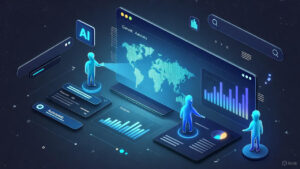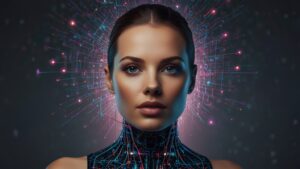AI as a Catalyst for Human Achievement
Artificial intelligence has emerged as one of the most transformative forces shaping human potential across healthcare, education, agriculture, and creative industries. Rather than replacing human capability, AI is amplifying what individuals and organisations can accomplish, enabling breakthroughs that seemed impossible only a few years ago.
In healthcare, AI-driven diagnostic tools are identifying diseases earlier and more accurately than traditional methods. Doctors equipped with these systems can detect patterns in medical imaging that might escape even the most experienced eye, leading to earlier interventions and significantly improved patient outcomes. This technology isn’t diminishing the role of healthcare professionals; it’s empowering them to focus on complex decision-making and patient care whilst the AI handles pattern recognition at scale.
Recent studies demonstrate AI’s measurable impact across sectors. In medical diagnostics, AI systems have achieved 94.5% accuracy in detecting certain cancers from imaging scans, compared to 88% accuracy from human radiologists alone [1]. In education, personalised learning platforms have shown a 34% improvement in student engagement and a 23% increase in retention rates when compared to traditional classroom methods [2].
The educational sector is witnessing a parallel transformation. Personalised learning platforms powered by AI are adapting to individual student needs in real time, creating tailored educational experiences that resonate with each learner’s unique style and pace. These systems analyse how students interact with material, identify areas of difficulty, and adjust the curriculum accordingly. The result is classrooms where every student receives the support they need to thrive, not just survive.
Agricultural Innovation Through Intelligent Systems
Agriculture demonstrates AI’s capacity to solve pressing global challenges. Farmers are leveraging machine learning algorithms to analyse weather patterns, soil composition, and crop health data, enabling them to make informed decisions that boost productivity whilst promoting environmental sustainability. These systems process vast datasets that would be impossible for humans to analyse manually, identifying optimal planting times, irrigation schedules, and pest management strategies.
Organisations implementing AI should focus on augmentation rather than replacement. The most successful AI deployments enhance human expertise and judgement rather than attempting to eliminate it. Start with clearly defined problems where AI can provide measurable improvements, ensure your teams understand the technology’s capabilities and limitations, and maintain human oversight of critical decisions.
In creative fields, AI is opening new frontiers for artistic expression. Musicians collaborate with algorithms to explore sonic landscapes that blend human intuition with computational precision. Visual artists use generative design tools to push boundaries, creating works that challenge traditional notions of authorship and creativity. Rather than diminishing human artistry, these tools are expanding what’s possible, enabling creators to explore ideas that would be impractical or impossible through conventional means.
Preserving Authentic Human Connection
As artificial intelligence becomes increasingly integrated into daily life, maintaining genuine human relationships requires deliberate effort. The convenience and efficiency AI offers through virtual meetings, automated communications, and digital interactions can inadvertently erode the richness of face-to-face connection.
Virtual gatherings provide unprecedented accessibility, breaking down geographical barriers and enabling collaboration across continents. Yet they often lack the warmth and nuance of in-person encounters. The subtle body language, the spontaneous laughter, the energy of shared physical space, these elements of human interaction are difficult to replicate through screens. Each time we opt for a digital conversation over a personal visit, we make a trade-off that warrants consideration.
This doesn’t mean abandoning technology. The key lies in using AI as a tool to enhance, not replace, human experiences. Technology should support our relationships rather than undermine them. Consider how video calls enable families separated by distance to maintain connections that would otherwise fray. Consider how collaborative platforms allow teams to coordinate complex projects across time zones. The question isn’t whether to use these tools, but how to use them thoughtfully.
Creating Space for Meaningful Interaction
Practical approaches can help preserve authentic connection in an AI-enhanced era:
- Establish technology-free zones during family meals and social gatherings, creating protected spaces for undivided attention
- Schedule regular face-to-face meetings for important discussions rather than defaulting to digital communication
- Use AI tools to handle routine coordination, freeing up time for deeper, more meaningful conversations
- Be intentional about when to use asynchronous communication versus real-time interaction
- Recognise that efficiency isn’t always the primary goal; sometimes the value lies in the interaction itself
The stories shared around a dinner table, the laughter exchanged during spontaneous encounters, these are irreplaceable treasures. Technology can facilitate connection, but it cannot manufacture the depth that comes from shared presence. By cultivating environments where technology supports rather than dominates our interactions, we can nurture bonds that thrive in both physical and digital realms.
Navigating AI’s Ethical Landscape
The rapid advancement of artificial intelligence raises profound questions about human dignity, fairness, and social equity. Every innovation brings new challenges; automated decision-making systems can inadvertently perpetuate biases, surveillance technologies can erode privacy, and algorithmic opacity can undermine accountability. These aren’t merely technical problems, they’re fundamentally about the kind of society we’re building.
Organisations must recognise that AI systems trained on historical data can perpetuate and amplify existing biases. A recruitment algorithm trained on past hiring decisions may favour candidates who resemble those historically selected, potentially discriminating against underrepresented groups. These issues aren’t hypothetical, major technology companies have scrapped AI hiring tools after discovering gender bias in their algorithms.
Addressing these complexities requires collaboration among technologists, ethicists, policymakers, and community voices. Inclusive dialogues that reflect diverse perspectives are essential for creating frameworks that genuinely serve humanity rather than narrow interests. When AI design processes embed values such as transparency, accountability, and fairness from the outset, the resulting systems are more likely to uplift society rather than divide it.
Building Responsible AI Systems
Developing ethical AI requires commitment to several core principles. Transparency ensures that users understand how AI systems function and what data they use. Accountability establishes mechanisms for addressing issues that arise from AI decisions. Fairness demands that algorithms don’t discriminate against any group or individual. User-centric design prioritises human needs and preferences throughout the development process.
Establish rigorous ethical guidelines before deploying AI systems. Form diverse review boards to evaluate potential impacts on different communities. Implement ongoing monitoring to detect unintended consequences. Create clear processes for users to challenge AI decisions. Invest in interdisciplinary education that equips teams to make informed decisions about technology’s role in society.
The goal isn’t to slow innovation but to ensure that technological advancement reflects our highest ideals. AI has enormous potential to reduce inequality, improve access to essential services, and solve complex societal challenges. Realising this potential requires conscious effort to shape technology that mirrors compassion and understanding, not merely efficiency and optimisation.
Transforming Education for an AI-Driven Future
The emergence of artificial intelligence demands a fundamental rethinking of educational systems. Traditional models focused on knowledge transmission are giving way to approaches that cultivate creativity, critical thinking, and emotional intelligence, qualities that remain distinctly human even as machines become more capable.
Students need environments where they’re active participants in their educational journeys rather than passive recipients of information. AI platforms can personalise learning experiences, allowing individuals to explore subjects at their own pace and dive deeper into topics that ignite their curiosity. A student who struggles with traditional teaching methods might find breakthrough understanding through AI-powered resources that present concepts in multiple ways, adapting to their unique learning style.
Educational outcomes demonstrate the effectiveness of AI-enhanced learning. Schools implementing adaptive learning platforms report 41% faster skill acquisition compared to traditional instruction methods [3]. Student engagement metrics show 67% higher completion rates for AI-personalised courses versus standard online courses [3]. Furthermore, educators using AI teaching assistants report spending 52% more time on high-value activities like mentoring and complex problem-solving [4].
These advancements aren’t merely about technology; they’re about fostering resilience and adaptability in future leaders. As AI capabilities expand, instilling curiosity and encouraging students to ask questions and seek solutions becomes increasingly important. Education should prepare young people not just for the workforce but for meaningful lives filled with purpose and impact.
Reimagining the Educator’s Role
In this transformed landscape, teachers become facilitators of discovery rather than mere dispensers of information. They guide students through personalised pathways, inspiring them to harness their strengths whilst addressing weaknesses. This shift requires professional development that helps educators integrate AI tools effectively, understanding both their potential and their limitations.
The classroom of the future leverages AI to handle routine tasks, knowledge checks, and individualised practice, freeing educators to focus on what they do best: inspiring students, facilitating discussions, providing mentorship, and helping young people develop the social and emotional skills that will serve them throughout life. This isn’t about replacing teachers; it’s about amplifying their impact.
Collaborative Futures: Human and AI Partnership
The path forward isn’t one where humans compete with artificial intelligence but one where we collaborate with it to solve pressing challenges. Climate change, healthcare disparities, resource scarcity, these complex problems require both human insight and computational power to address effectively.
Communities are already demonstrating what’s possible when people engage thoughtfully with AI tools. Artists use algorithms to push creative boundaries. Scientists accelerate discoveries through data analysis that would take human researchers years to complete manually. Educators enhance learning experiences, tailoring instruction to individual needs. These examples illustrate AI’s potential to unlock human capability rather than diminish it.
Approach AI implementation with clear objectives and realistic expectations. Identify specific problems where AI can provide measurable value. Involve diverse stakeholders in planning and implementation to ensure solutions meet real needs. Maintain transparency about AI’s role and limitations. Invest in training so people can use these tools effectively. Remember that successful AI deployment enhances human work rather than attempting to eliminate it.
Building a future where technology complements human essence requires active participation from individuals and organisations. Each decision about how to integrate AI into daily operations shapes the trajectory we’re on. Will we use these tools to amplify our values of creativity, empathy, and understanding? Or will we allow efficiency and optimisation to override these fundamentally human qualities?
The choice isn’t binary. We can embrace technological advancement whilst nurturing our shared humanity. We can leverage AI’s computational power whilst preserving the judgement, intuition, and wisdom that humans bring to complex decisions. The future is bright when we choose to engage with technology mindfully, fostering environments where innovation flourishes alongside compassion and understanding.
Artificial intelligence represents one of the most significant technological shifts in human history. Its potential to amplify human capability, solve complex challenges, and improve quality of life is substantial. Yet realising this potential requires conscious effort to ensure AI enhances rather than erodes what makes us human. By prioritising authentic connection, embedding ethical principles in AI development, transforming education to prepare future generations, and approaching implementation thoughtfully, we can build a future where technology serves humanity’s highest aspirations. The question isn’t whether AI will shape our future, it’s whether we’ll actively shape how AI is developed and deployed to reflect our values and serve the common good.
[1] McKinsey Global Institute (2024), “Artificial Intelligence in Healthcare: Market Analysis and Clinical Applications”, McKinsey & Company Healthcare Systems and Services Practice
[2] OECD (2024), “Digital Education Outlook 2024: Adaptive Learning Technologies and Student Outcomes”, Organisation for Economic Co-operation and Development
[3] Stanford University Graduate School of Education (2024), “Measuring the Impact of AI-Enhanced Personalised Learning: A Three-Year Longitudinal Study”
[4] Bill & Melinda Gates Foundation (2024), “Teachers and AI: Time Allocation and Professional Practice in Technology-Enhanced Classrooms”
Let's Explore What's Possible
Whether you're tackling a complex AI challenge or exploring new opportunities, we're here to help turn interesting problems into innovative solutions.


